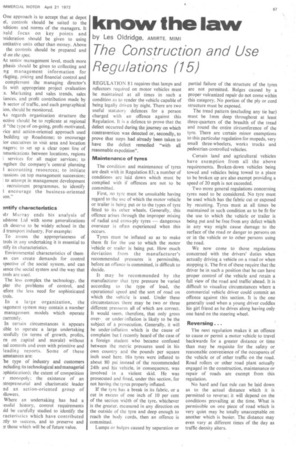know the law
Page 65

If you've noticed an error in this article please click here to report it so we can fix it.
by Les Oldridge, AMIRTE, MIMI
The Construction and Use Regulations (15)
REGULATION 81 requires that lamps and reflectors required on motor vehicles must be maintained at all times in such a condition as to render the vehicle capable of being legally driven by night. There are two useful statutory defences for a person charged with an offence against this Regulation. It is a defence to prove that the defect occurred during the journey on which contravention was detected or, secondly, to prove that steps had already been taken to have the defect remedied "with all reasonable expedition".
Maintenance of tyres
The condition and maintenance of tyres are dealt with in Regulation 83; a number of conditions are laid down which must be complied with if offences are not to be committed.
First, no tyre must be unsuitable having regard to the use of which the motor vehicle or trailer is being put or to the types of tyre fitted to its other wheels. Generally, this offence arises through the improper mixing of radial and cross-ply tyres — dangerous oversteer is often experienced when this occurs.
Tyres must be inflated so as to make them fit for the use to which the motor 'vehicle or trailer is being put. How much deviation from the manufacturer's recommended pressures is permissible, before an offence is committed, is difficult to decide.
It may be recommended by the manufacturer that tyre pressure be varied according to the type of load, the operational speed and the sort of road on which the vehicle is used. Under these circumstances there may be two or three different pressures all of which are correct. It would seem, therefore, that only gross over-, or under-inflation is likely to be the subject of a prosecution. Generally, it will be under-inflation which is the cause of complaint but I recently heard of the case of a foreign student who became confused between the metric pressures used in his own country and the pounds per square inch used here. His tyres were inflated to about 80 psi instead of the recommended 24lb and his vehicle, in consequence, was involved in a violent skid. He was prosecuted and fined, under this section, for not having the tyres properly inflated.
If the tyre has a break in its fabric, or a cut in excess of one inch of 10 per cent of the section width of the tyre, whichever is the greater, measured in any direction on the outside of the tyre and deep enough to reach the body cords, then an offence is committed.
Lumps or bulges caused by separation or partial failure of the structure of the tyres are not permitted. Bulges caused by a proper vulcanized repair do not come within this category. No portion of the ply or cord structure must be exposed.
The tread pattern (excluding any tie bar) must be lmm deep throughout at least three-quarters of the breadth of the tread and round the entire circumference of the tyre. There are certain minor exemptions to this particular regulation for mopeds, very small three-wheelers, works trucks and pedestrian-controlled vehicles.
Certain land and agricultural vehicles have exemption from all the above requirements. Broken-down vehicles being towed and vehicles being towed to a place to be broken up are also exempt providing a speed of 20 mph is not exceeded.
Two more general regulations concerning tyres need to be considered. No tyre must be used which has the fabric cut or exposed by recutting. Tyres must at all times be maintained in such condition as to be fit for the use to which the vehicle or trailer is being put and be free from any defect which in any way might cause damage to the surface of the road or danger to persons on or in the vehicle or to other persons using the road.
We now come to those regulations concerned with the drivers' duties when actually driving a vehicle on a road or when stopping it. The first of these require that the driver be in such a position that he can have proper control of the vehicle and retain a full view of the road and traffic' ahead. It is difficult to visualize circumstances where a commercial vehicle driver could commit an offence against this section. It is the one generally used when a young driver cuddles his girl friend as he drives along having only one hand on the steering wheel.
Reversing ...
The next regulation makes it an offence to cause or permit a motor vehicle to travel backwards for a greater distance or time than may be requisite for the safety or reasonable convenience of the occupants of the vehicle or of other traffic on the road. Road rollers or other road plant actually engaged in the construction, maintenance or repair of roads are exempt from this regulation.
No hard and fast rule can be laid down as to the actual distance which it is permitted to reverse; it will depend on the conditions prevailing at the time. What is permissible on one piece of road which is very quiet may be totally unacceptable on another which is busier. The distance may even vary at different times of the day as traffic density alters.












































































































